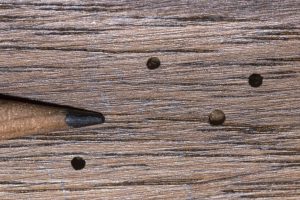THIS POWDERPOST BEETLE CAN DAMAGE WOOD IN YOUR HOME
By Chris Williams on January 23, 2018.
There are a couple of different types of tiny powderpost beetles that can infest wood in homes, often hardwood floors or furniture. The anobiid powderpost beetle, however, is more likely to damage structural wood as it infests both softwoods and older hardwoods. These powderpost beetles require high moisture levels and most often attack unfinished wood used for framing, flooring, and joists. The beetles can re-infest structural wood or can even infest furniture if wood moisture and other conditions are favorable.
THESE BORERS PREFER UNFINISHED WOOD IN DAMP AREAS
Infestations often start at ground level or below, in damp areas of the home that are rarely visited. In crawlspaces or unfinished basements or garages, materials may be stacked and blocking areas where damage is slowly occurring. The white, grub-like powderpost beetle larvae do all the damage, tunneling and feeding inside the wood for a couple of years. They then pupate in their galleries inside the wood. Adult beetles later emerge from the wood through tiny, round emergence holes that are about 1/10-inch in diameter. Often the first signs of an infestation are these holes in joists or floorboards.
PILES OF POWDERY WOOD “FRASS” ARE CLUES
When the adult beetles emerge from infested wood, they push out powdery wood frass or sawdust from the hole as they exit. The light-colored, gritty frass accumulates in little piles under the emergence holes but it is easily overlooked in crawlspaces or basements where it looks like so much dust, or it may be disturbed by cleaning or other activities. The exit holes themselves may not be noticed until there are many of them in the same section of wood. So before powderpost beetles are discovered, infestations may be several years old and damage can be significant.
YOU MAY NEVER SEE THE ACTUAL BEETLE INVOLVED
Adult anobiid powderpost beetles generally emerge from the wood in late spring or early summer and may find their way to windows or lights. Adult beetles may never be seen though, especially if they emerge in a crawlspace or unfinished basement, because they are small (1/32 to 3/8-inch long), active at night, and die fairly quickly.
LOOK FOR TINY, ROUND EMERGENCE HOLES IN WOOD

Small round PPB exit holes. Sutterstock
The best evidence of a powderpost beetle infestation is the emergence holes in wood. The holes can be old though, belonging to an earlier infestation that is no longer active (see Are the Holes Old or New Powderpost Beetle Damage?). The presence of new holes with fresh frass beneath the holes indicates an active infestation. Cutting into infested wood may reveal larvae inside their galleries or adult beetles may be found nearby to verify an infestation. A pest control professional can determine if an infestation is ongoing or no longer active.
If you suspect that you have powderpost beetles infesting wood in your home, call Colonial Pest. Our technicians will conduct a thorough inspection to find infested areas. If the infestation is active, controls can range from replacement of infested wood to treatment of infested wood with a borate product that penetrates and kills the larvae inside.
For more on powderpost beetle infestations, see Renovation Exposes Tiny Holes in Wood.